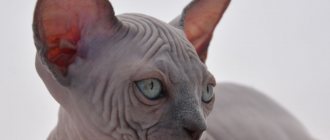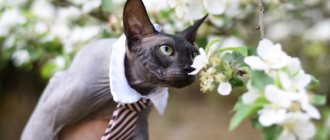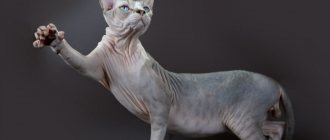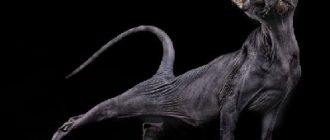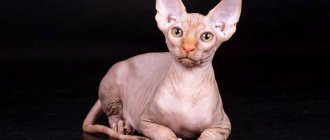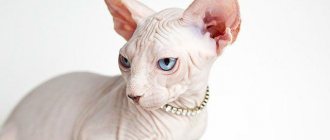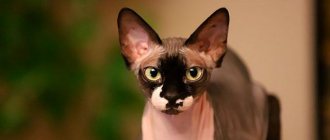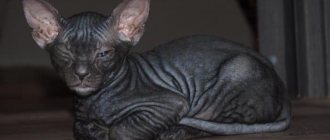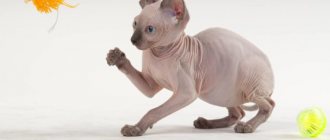No wool. With folds on the skin. Pot-bellied. With locator ears. With huge eyes... But still, this is a real cat. Someone will say: “The Canadian Sphynx is a freak!” But those who were lucky enough to get to know this amazing creature better consider the “moon cat” to be the most beautiful, charming, intelligent and loving creature in the world.
Hairless cats can be treated differently. However, due to their non-standard appearance, there is always increased interest in them. It is impossible not to notice, not to talk about them. Where did this unique breed come from and why is it considered one of the elite of the cat world?
History of the Canadian Sphynx breed
Canadian Sphynx
Although the breed is quite young, the existence of hairless cats is mentioned in the annals of various civilizations. The thing is that “bald” offspring can appear from completely ordinary parents as a result of a natural mutation. Most often, such animals were considered an anomaly and were discarded by humans.
There is evidence of the emergence in South America of an entire population of graceful creatures with amber-colored eyes. True, unlike Canadians, they could be partially covered with wool during the cold season, and wore mustaches all year round. It is impossible to judge the genetic characteristics of these animals today, since the breed has disappeared. The last individuals whose existence is documented lived in the 20s of the last century, but then “Inca cats,” as the Mexicans called them, did not interest professional breeders.
40 years have passed, and much further north, in the Canadian province of Ontario, the owner of a black and white short-haired cat named Elizabeth was surprised to find an unusual specimen in her pet’s litter. The kitten was given the name Prune (English: Prune) and, upon reaching maturity, was crossed with its own mother. The first experiments seemed successful, but already in the early 1970s the line was interrupted.
Around the same time, a new stage in the history of the breed began. In one of the catteries in Baden, Minnesota, two cats were devoid of fur at once. All modern elite lines trace their pedigree back to them, although the selection process, of course, included cats of different breeds. The best results were achieved by working with Devon Rexes; “naked” kittens, which were again discovered among our northern neighbors, actively participated in the creation of the breed. They were originally called “Canadian hairless cats,” but enthusiasts wanted something more sonorous and drew parallels with the oldest surviving monumental sculpture - the Egyptian Great Sphinx, which guards the peace of ancient rulers in Giza.
Recognition from international felinological organizations did not come immediately. There were concerns that the mutation was causing serious health problems. When time showed the inconsistency of these theories, The International Cat Organization (TICA) was the first to allow Sphynx dogs to participate in its exhibitions in 1986. After 6 years, champion status was received from the Canadian Cat Association (CCA), but the breed standard according to the authoritative The Cat Fanciers' Association (CFA) was approved relatively recently, in 2002.
WCF breed standard
photo from website: PipCat.ru
- Strong muscular body, medium in size. The chest is wide, the stomach is rounded. Graceful paws with long movable toes. The tail is whip-like, flexible and thin, and may have a tassel at the end.
- Wedge-shaped head with pronounced cheekbones, giving the animal’s muzzle a smooth outline. Characteristic profile.
- Ears set wide apart, large and wide at the base. The presence of fluff on the outside is allowed.
- Pronounced belly pads are desirable. The skin on the face, neck and limbs should be covered with folds. There may be fur that looks like invisible fluff, making the body velvety to the touch.
- The disadvantages of the breed are its proximity to the Devon Rex, Cornish Rex.
- The eyes are large, lemon-shaped, set at a slight angle. As a rule, the shade is in harmony with the color.
Appearance of the Sphinx
Sphynx kittens
Sphynxes are not large breeds. Females usually weigh 3.5-4 kg, males weigh between 5-7 kg. At the same time, the body is muscular and dense, which is why cats actually turn out to be heavier than one might expect given their size. The skin is thick and gathers into characteristic folds, especially pronounced on the muzzle.
Head
Medium in size, shaped like a slightly rounded modified wedge, where the length is slightly greater than the width. The forehead is flat, the transition from it to the muzzle can be either quite soft or clearly pronounced. The muzzle is short. The cheekbones are high and clearly defined. The chin is strong and forms a perpendicular to the upper lip. The nose is short, with a slight to medium stop. The whisker pads are well developed, although the whiskers themselves are completely or almost completely absent.
Ears
Ears are one of the distinctive features of the Canadian Sphynx breed. Very large compared to the head. Upright and open. The base is wide. The inner surface is without wool.
Eyes
The eyes of sphinxes are large, shaped like a lemon, because with a wide middle part they narrow equally on both sides. Set wide and slightly slanted. The color is not regulated, but must be in harmony with the color.
Neck
Medium length, slightly arched, with well-developed muscles.
Face of the Canadian Sphynx
Body
Sphynx paws
The body of the sphinx is of medium length, muscular. The chest is wide and rounded. The belly is round and full. The back of the body is rounded.
Legs
Medium length, proportional to the body. Strong and muscular. The hind ones are slightly longer than the front ones.
Paws
Oval, with thick pads and well-developed long toes.
Tail
White Sphynx
The length of the Sphynx's tail is proportional to its body. Graceful and flexible, gradually tapering from base to tip.
Cover and skin
The skin of the Canadian Sphynx is thick and forms folds, which are especially numerous on the face and legs. They seem completely hairless, but usually the body is covered with delicate down (a length of no more than 2 mm is allowed). The norm is the presence of short, sparse hair on the outside of the ears, tail, between the toes and in the scrotum area. The bridge of the nose is covered with the usual short hair for cats.
Color
Despite the lack of hair in the usual sense, sphinxes have many colors: white, black, red, chocolate, lilac (lavender), tabby, tortoiseshell, two-color, calico (tri-color), color point, mink. Neither conflicts with the CFA standard.
Interesting facts about the Don Sphynxes
- Naked cats sweat.
- The bodies of completely naked, “rubber” Don cats are covered with a sticky film.
- Sphynx cats have a fast metabolism, so they should be fed more often than regular “furry” purrs.
- The Don cat is a super healer! Cats have long been considered healers for their ability to find a diseased organ in a person, then lie on it, and warm the sore spot with the warmth of their body. Due to their elevated body temperature, sphinxes can rightfully be considered super-healers, since the healing effect of contact of human skin with the naked skin of a cat is much higher.
- Injecting a sphinx is very problematic due to the thickness of the skin and the abundance of folds.
Photo of the Canadian Sphynx
Reproduction
Mating for the purpose of reproduction is categorically not recommended for an ordinary person without the appropriate education. Due to hereditary genetic health problems, newborn kittens may be born with abnormalities or non-viable.
Pregnancy and childbirth should also occur under the supervision of a specialist. Sphinxes' estrus lasts 5-8 days. Pregnant cats require extra attention and affection and can become aggressive.
The baby is born with a small fluff. In the first weeks, mother cats constantly lick their babies for cleanliness, good blood supply and organ function.
The animal is castrated no earlier than the kitten reaches 10 months.
How long do Canadian Sphynxes live?
The average life expectancy of sphinxes is 14 years. Some individuals manage to live up to 20 years.
With proper care and early detection of diseases, life expectancy can be significantly extended. Much depends on the conditions in which the sphinx lives.
The character of the Canadian Sphynx
The ancient sculpture of a lion with a human head, lost in the African sands, was once called differently by Arabic speakers - Abu al-Haul, that is, the Father of Terror. But her little namesakes don’t seem at all intimidating to their owners. These are real “tails” that will follow a person everywhere and will not miss the opportunity to settle on his lap.
This sphinx has found its place
However, such affection is not at all an indicator of laziness. Sphinxes are very mischievous and playful creatures; they get involved in active fun with great excitement or independently come up with entertainment for themselves, such as “hunting” for a beetle that happens to be in the apartment. Games should be versatile and challenge not only dexterity and muscle strength, but also the intellect.
Sphinxes do not tolerate loneliness well, which should be taken into account by potential owners whose work involves frequent and long business trips. Canadians are attached not to a place, but to “their” people, so separation is a difficult test for them, even if in your absence the care of your pet is entrusted to reliable and kind hands.
Sphynxes are absolutely not aggressive, so they get along well with children of different ages and calmly share their home with other pets. Moreover, they know how to be friends with both cats and dogs, which helps brighten up the long hours of waiting to meet a person.
Representatives of this breed get used to being in large crowds of people quite easily. Thanks to this, sphinxes feel good at exhibitions, and some bring the skill of equanimity to such a level that they become real movie stars. The most striking example of this is Ted Nugent, who played the role of Mr. Bigglesworth, Dr. Evil's cat from the famous Austin Powers film series.
Breeding
Female Sphynx cats become sexually mature at 6-7 months, males at 7-8 months. But early matings are dangerous for the health of animals and are fraught with the birth of weak offspring. Therefore, it is advisable to carry out the first crossing no earlier than 18-24 months.
Be sure to read:
Differences between the Don Sphynx and the Canadian Sphynx
The gene responsible for the lack of hair in Sphynx cats is recessive. And to get hairless kittens, both parents must be carriers. To consolidate the best breed qualities, many breeders practice inbreeding. But in the absence of sufficient experience, it is better to refrain from such experiments.
Pregnancy in Canadian Sphynx cats lasts about 60-68 days and ends with the birth of 1-12 kittens. Some babies appear with rex hair, but by three months they are completely bald.
Important! Canadian Sphynx cats cannot be crossed with representatives of any other breeds. For example, Canadians and Don Sphynxes have different genes for hairlessness, and as a result of their combination, sick kittens can be born.
Care and maintenance
Having no hair may seem like a big advantage to a busy owner, but in fact, Sphynx cats require even more care than their furry counterparts. The sweat and sebaceous glands in these cats work in “normal mode”, so a kind of plaque forms on the surface of the skin, which provokes the appearance of greasy stains on the owners’ clothes, bedding and upholstery.
Canadian Sphynx in a sweater
To avoid this, hygiene procedures should be carried out regularly. Some people think that it is enough to wipe the cat’s body with wet wipes that do not contain alcohol or fragrances. But most agree that the optimal solution to the problem is weekly bathing with special mild products or baby shampoo. If you accustom a kitten to them from an early age, the process will happen quickly and without much hassle. Please note that immediately after a bath the sphinx must be wrapped in a towel!
The issue of hypothermia is generally quite acute for representatives of this breed. When you hold a hairless cat in your arms, it seems really hot. The fact is that due to the lack of a fur “buffer”, heat exchange with the external environment is much more active in them than in other animals. This means that in a cool room the sphinx will freeze no less than a naked person, so buying special clothes for winter and the off-season will not be superfluous even for permanent residents of city apartments.
By the way, experienced breeders recommend exclusively keeping Canadian Sphynxes at home. If you consider it necessary for your pet to stay in the fresh air, it is better to limit its duration and monitor the cat at all times. Independent walks are contraindicated not only because of the risk of colds or sunburn (yes, Sphynx cats can get tanned and burn, so in the summer they need sunscreen!). Thanks to its characteristic appearance, even a layman can easily recognize your pet as a purebred, which means a potentially expensive animal, which can lead to kidnapping.
We didn't find a house and organized it ourselves
Other care tips differ little from the standard ones. It is important to monitor the condition of the eyes and ears to avoid infections. Regular brushing of your teeth with a special paste guarantees protection from tartar, and trimming your nails will help keep your furniture and walls in their original condition.
The cat will be grateful for a personal “house” with the opportunity to climb higher and play hide and seek, but most sphinxes prefer the owner’s bed, where you can comfortably sit under a warm blanket, to a soft bed.
All sphinxes have an excellent appetite. This is another side effect of not having fur, as they require more energy than other cats due to their intense heat exchange. The main thing is that the quality of the food is at a high level and fully satisfies your pet’s needs for proteins, fats, carbohydrates, vitamins and minerals. The easiest way to achieve this balance is with specialized premium and super premium food. But if you are willing to spend time creating a healthy menu of foods, natural nutrition will be a worthy alternative.
Leftovers are sweet
Canadian Sphynx having a meal
Health
Canadian Sphynx cats have good immunity and, with proper care, live an average of 13-14 years. Like any other animals, these cats have a predisposition to certain pathologies.
Most often, the following diseases are diagnosed in Canadian Sphynx cats:
- myopathy;
- hypertrophic cardiomyopathy;
- airway obstruction;
- turning of the eyelids;
- breast cyst;
- dermatitis;
- acne;
- inflammation of blood vessels;
- gum hyperplasia;
- skin cancer;
- urticaria pigmentosa.
Health and illness of the Sphinx
Cute sphinx
In general, with the right diet and proper care, sphinxes are infrequent patients of veterinary clinics. Problems can be caused by hypothermia, prolonged exposure to the sun, neglect of hygiene rules on the part of the owners, and lack of immunity due to missed vaccinations.
But there are also breed-specific diseases. The weak point of Canadians is sensitive skin; it can be affected by urticaria pigmentosa. Redness and rashes on the body can also be symptoms of allergies, including food allergies. Only a doctor can determine the exact cause and prescribe treatment based on test results.
Like Maine Coons, Sphynx cats suffer from hypertrophic cardiomyopathy. This dangerous heart disease is caused by a genetic mutation, but to date there is no convincing evidence that heredity has a decisive influence on its development.
But another disease of sphinxes, myopathy, is transmitted to descendants from parents. They got it in the process of selective work with Devon Rex. Progressive muscle dysfunction has no cure, progresses individually and often leads to death as a result of laryngospasms. Usually appears at 4-7 weeks of age, but may be asymptomatic until 12-14 weeks. The nursery must warn you if the kitten is at risk.
Characteristics of the Don Sphynx - character and habits
The peculiar appearance of the Don breed sphinxes makes an indelible impression. Unusual hairless cats with large ears and folds all over their bodies are affectionate, not cat-like wise, and have a friendly disposition. With its expression of extreme concentration on its folded muzzle, the Donchak looks more like a pensive alien than a representative of the feline family.
Don cats are very social animals and love tactile contact. For good behavior, the Donchak expects a mandatory reward from the owner - a hairless cat always counts on stroking and other manifestations of affection. Due to their excessive affection, some animal lovers call the Don Sphynx a “kissing” breed.
How to choose a kitten
The main advice is the same for all purebred animals: do not try to save money on your purchase by going to the “bird market” or responding to a random ad. Only the best nurseries and breeders with an impeccable reputation will guarantee that you will receive a healthy pet, the origin of which cannot be doubted. After all, the Canadian Sphynx is not just a lack of hair, but a graceful, beautifully built, affectionate and intelligent creature that will live next to you for the next few years.
If you do not plan to participate in exhibitions, it is enough to make sure that the chosen baby is healthy and active, easily makes contact with people, without showing fear or aggression. The rest will be determined by the available documents (pedigree, veterinarian’s report, vaccination card). We recommend getting to know the parents and looking at the living conditions - they will say a lot about the breeder’s attitude towards the cats.
Character
Sphynxes are affectionate and friendly animals. Usually they choose one person and become strongly attached to him. At the same time, the owners are treated as equals and do not try to please them.
These animals are in dire need of warmth - both literally and figuratively. They love the attention of their owner, while trying to be as close to him as possible in order to warm up. They sit happily in your arms and love to spend the night in their master's bed, under the blanket. To the best of their ability, they take part in all the affairs of their person and accompany him around the house. They can “maintain a dialogue” by meowing in response to words addressed to them, and their “speech” is distinguished by great intonation diversity.
Many owners claim that Sphynx cats love to pose in front of a camera or video camera. This breed is a champion in the number of roles in films.
Sphinxes treat children well and even try to “educate” and protect them in their own way. They are balanced and unvindictive - they need company too much to allow themselves to show resentment for a long time. Sphinxes are active, inquisitive, easy to train and quickly adapt to new conditions.
In good weather, sphinxes can be walked on a leash
They are friendly towards new people, and sometimes they can choose their favorite guest to whom they will pay special attention. They treat other animals well; most often they are not afraid even of unfamiliar dogs.
Sometimes, due to too active games, something can break or break. Some individuals are unclean, in particular, they neglect the litter box and do not lick themselves after using the toilet. They can steal food.
Sociable is too small a word to describe this creature. Now you will always brush your teeth together, take a bath, watch TV, read a book, cook dinner, clean the house, and, of course, sleep. Since childhood, the Sphinx believes that there is no better assistant in the world than him. He alone knows how to properly stir salad, arrange your figurines on shelves and take a bath. There is no use in getting angry about this. Just get used to the fact that a bald fat belly is always jumping next to you.
Sattvika
https://otzovik.com/review_1163751.html
Photo of the Canadian Sphynx
Colors
The coat color of the Canadian Sphynx is determined by the characteristics of skin pigmentation. The color of the skin becomes clear within a few hours after birth. The range of colors of sphinxes is varied.
Solid
These colors are also called solid. This means that in the pet's color, one color predominates. The color of the nose and paws should match the pigmentation of the skin. Solid color can be:
- white;
- lilac;
- cream;
- blue;
- black;
- chocolate;
- red.
Canadian Sphynx color code table.
Tortoiseshell colors, like other cat breeds, are typical only for females. Sphynx pigmentation occurs when two colors are mixed. The classic version is characterized by black and red colors. In the lightened type, these are blue and cream. Proportions and color options can be very diverse.
Bicolor animals can have any of the solid colors in combination with white. The colored part of the body has clear boundaries, and the proportion of white color is not a third, but in some cases up to half. One of the ears must be painted. The tail is also colored and has a white tip.
White Sphynx
Lilac sphinx
Cream Sphynx
Blue Sphynx
Black sphinx
Chocolate color
Red Sphinx.
Color point
Such kittens are initially born white; after a few days the animal acquires its color. This type has several varieties:
- Cream point. Rare color for this breed. The body is light cream in color, the eyes are blue, the nose and paw pads are pink.
- Seal point. These cats are light brown or black-brown. Adults gradually darken, but the back is darker than the rest of the body.
- Chocolate point. The color is lighter than seal point. An adult cat is golden brown in color.
- Tabby point (links). The body is light, on the muzzle, paws and tail there are stripes with a dark edging.
Such colors are rare for this cat breed, and such individuals are highly valued among breeders and lovers of the Canadian Sphynx breed.
Color point sphinx.
Harlequin
This type of color is an intermediate state between van and bicolor. There should be at least one spot on the head and several spots on the body, tail, and legs. The paws and nose are pink in color.
Wang
The animal is predominantly white in color. The tail and ears are colored in a contrasting color. No more than three spots of a different color are allowed on the body.
How much does a Sphynx cost?
If you are offered to buy a Sphynx kitten for 3-4 thousand rubles, you can rest assured that there can be no talk of any pedigree here.
The price of kittens in trusted nurseries starts from 8-10 thousand rubles. Children who have more or less significant deviations from the breed standard are cheaper. They are perfect for those who dream of a pet with an extraordinary appearance and character.
Prospective exhibitors whose parents can boast of championship titles and other titles will cost their future owners at least 15 thousand rubles.
Peace-loving aliens: everything we love them for
photo from the site: zooclub.ru
Despite the lack of fur on their bodies, these pets are extremely charming and attractive - porcelain figurines come to life. In their grace, they surpass even the Abyssinian cats, which we wrote about earlier. Their distinctive feature, which is noted by more than one owner, is their exceptional attention to the owner and the ability to look into his eyes without looking away. Why not a mythical zoomorph?
Photos of Sphynx kittens evoke different feelings in everyone - some compare the babies to rats, while others admire the folds of skin covering their bodies. However, you can’t argue with one statement - the Sphinx always causes controversy because it has an incredibly impressive appearance. If you want to own a real alien creature that meows invitingly when greeting its owner from work, this breed is for you.
photo from the site: zooclub.ru
However, this animal is suitable not only for lovers of the exotic, but also for those who are accustomed to the traditional image of a cat - a purring guardian of the hearth. The incredible energy of hairless pets, their curiosity, intelligence and warm heart - this is what makes it worth loving the sphinxes, who found recognition in Europe forty years ago.
Hairless cats with big eyes seem like toys, but before purchasing such an animal you need to learn everything about its maintenance and care for representatives of the breed. We wrote about how to choose a pet in a large article on this topic. We would like to add that before purchasing such a specific creation, you need to consult with specialists. Be prepared for the fact that an unusual cat will require more attention than the yard Murka.
How to determine that it is a sphinx in front of you? Many believe that the mandatory attributes of this breed are wide ears, huge eyes and skin without the slightest sign of vegetation.
We offer our vision of the breed:
- The lines of the body form soft outlines.
- The silhouette lacks everything straight, sharp, and angular.
- The shapes are necessarily slightly convex, not without an attractive roundness.
- The tail is flexible, like rubber, curved and curled.
Let us repeat: this description is not a breed standard, but how we see these graceful animals when we first meet them. Next, we will talk in more detail about what distinguishes the Canadian Sphynx from our other smaller brothers, those features that make it exceptional for both breeders and ordinary owners.
